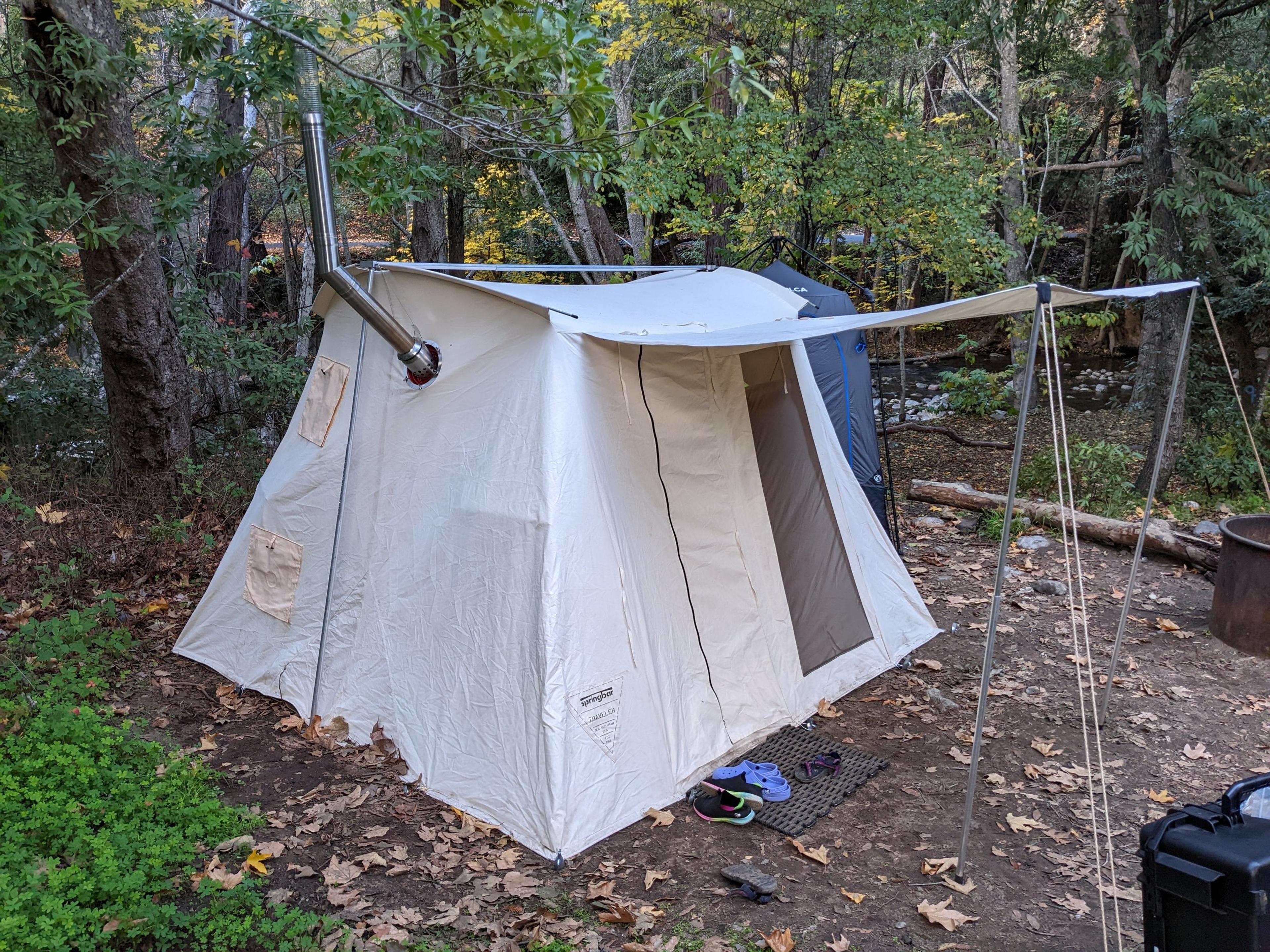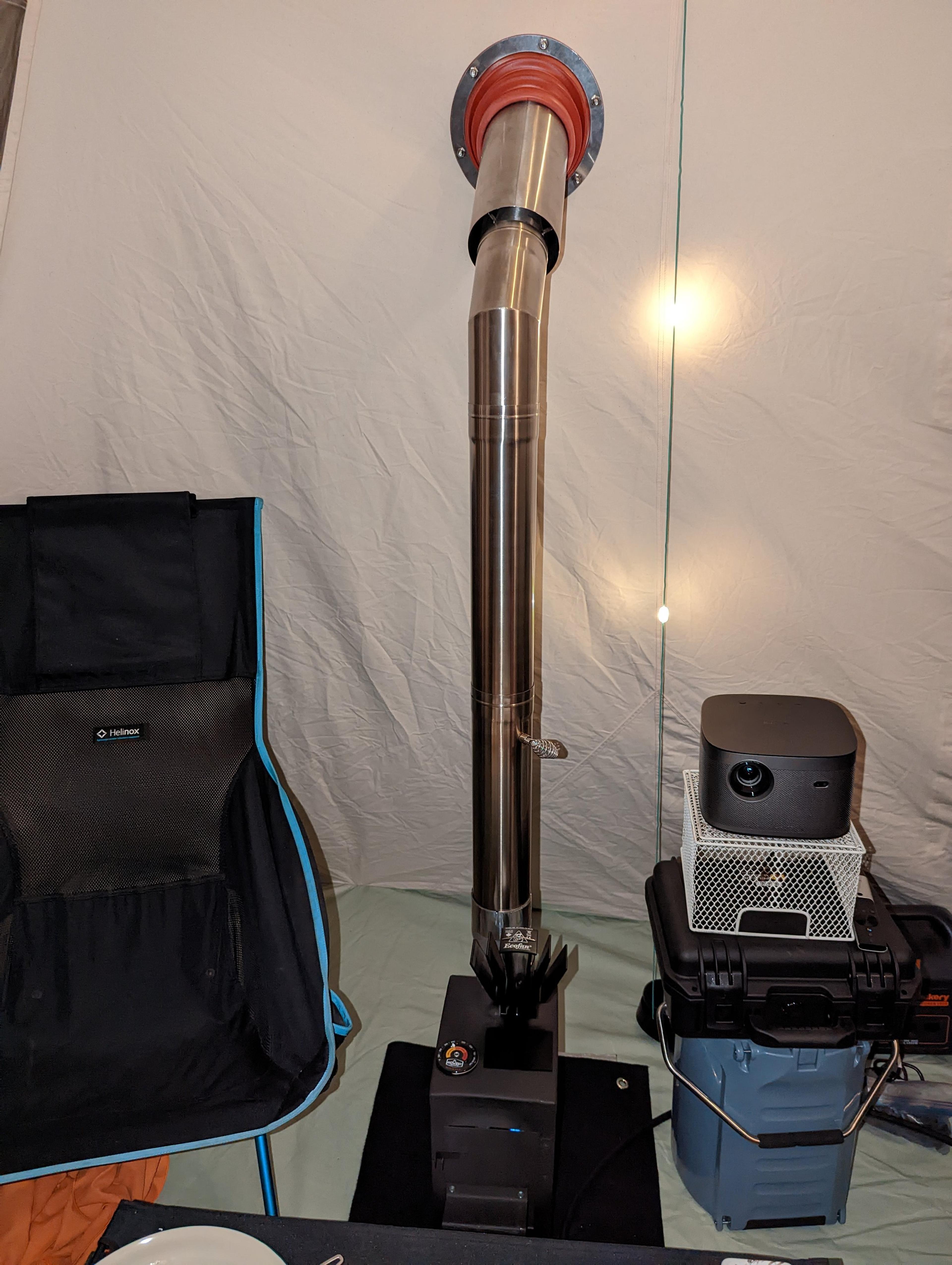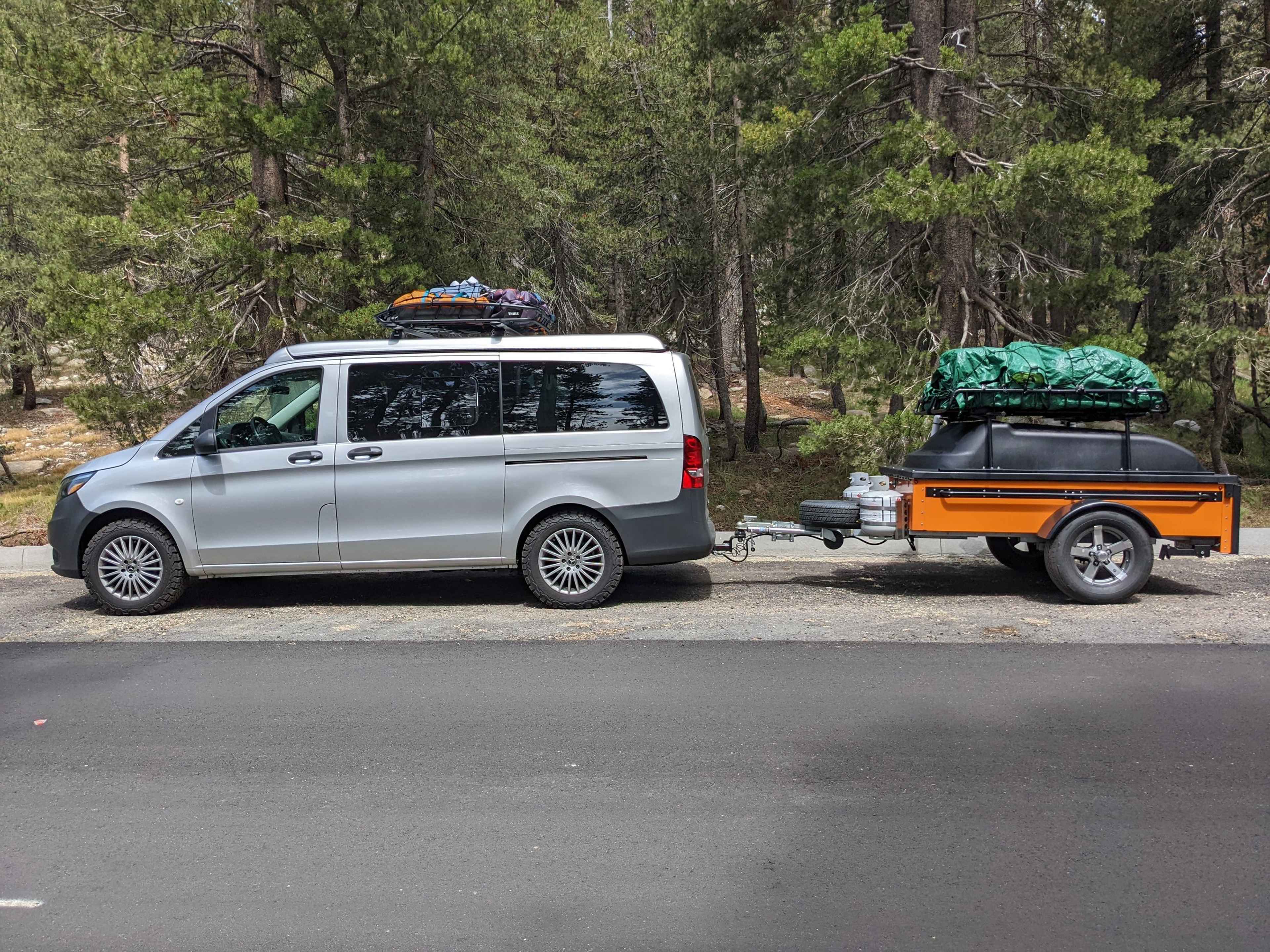The Best Camping Heaters: What You Need to Keep Your Tent Warm

Springbar Traveler tent (similar to the Springbar Highline 6) with the Nu-Way Model 3500 External Gas Heater © Outdoorithm
Camping in winter or even in shoulder seasons is made much more comfortable if you can heat your tent. We've found two solutions which work great for us when car camping: the Propex External Gas Air Heater for chilly but more moderate temperatures and the Nu-Way Model 3500 propane stove for colder nights.
Both options provide warm, dry air that makes for a comfortable, toasty tent. Below you'll find a detailed list of everything you need to assemble and set up the heaters. The descriptions are on the more technical side but are necessary for you to understand how the heaters work and how to build them so you can camp both comfortably and safely.
But first: the Mr. Heater Buddy. If you've looked into heating your tent, you've probably come across this very popular solution. It works great in some circumstances, such as day-use in a more open space (e.g. a fishing hut) or for adults sleeping in a well ventilated tent that is large enough to keep the Mr. Heater Buddy away from anything flammable. However, we find that for family tent camping the concerns outweigh the benefits. Though our tent was well ventilated, we still experienced quite a bit of condensation and the fumes made us feel a little off. It was also very nerve racking keeping it out of the way of anything flammable (i.e. our sleeping bags) in a confined space like a tent, especially with kids. It does have tip over protection, but if something like a blanket fell on top of it, it could cause a fire. It also has a low oxygen sensor which should shut the heater off if the oxygen levels get too low but you do need to check this very regularly to make sure that the sensor is working properly.
In this safety video they take the Mr. Heather Buddy to a fire station to get an accurate gauge of oxygen and carbon monoxide levels. They did find it to be safe overall, though they emphasized the need for proper ventilation and expressed concerns about having it in tight spaces with kids and flammable objects. So, we’re not discouraging it’s use just noting its best use cases and the importance of taking safety precautions.
Our Propane Heater Recommendation: The Propex External Gas Air Heater
If you want to take the edge off of a chilly night camping and the temperature isn’t going to drop below 40 degrees or so, a propane heater designed for vans can be quite effective at keeping your tent warm. These heaters are designed for versatile usage in various vehicles and small spaces, providing around 6500 BTUs of clean, dry, and warm air.
What is a BTU? BTU stands for British Thermal Unit. It's a traditional unit of heat energy that is often used to measure the heat output of different devices, including heaters like the ones you might use camping. When you see a heater rated with BTU, it tells you how much heat the heater can produce.
With a digital thermostat included, they allow easy temperature control for steady tent warmth. A key advantage relative to other options like the popular Mr. Heater Buddy is that the Propex External Gas Air Heater ensures safety by separating the combustion from the tent, eliminating risks of condensation and carbon monoxide intrusion. The unit is placed in a case which stays outside your tent and then blows air over a heater exchanger, which warms up the air and then blows this air into your tent. Because the heat exchanger is separate from where the combustion takes place, you get the benefit of warm, dry air blowing into your tent without any combustion gas.
We recommend the Propex HS2211 6500 BTU External Gas Air Heater. Its unique, weatherproof design allows external mounting, making it ideal for campervans, trailers, tiny homes, boats, and more, without occupying valuable indoor space. While this unit can be used without a case, we installed ours inside of Pelican Storm iM2620 Case Without Foam (Olive Drab).
For How Long Will It Run?
Our calculations, based on real world usage, show that you can get about 60 hours of run time on a Propex heater with a 20 lb. propane tank. Since the heater cycles on and off once the temperature has been reached, it can last you 10+ nights. The more limiting factor will be your battery. You can get about 15 hours of continuous use on a Jackery 300, which should be enough for a weekend trip. If you plan on being out in cold weather longer, you'll want to step up to a Jackery 1000.
What You'll Need
We’ve built this one ourselves so we know exactly what it takes. If you’re going this route, you’ll need to buy a number of parts in order to get everything installed correctly, including the following:
Electrical
The Propex HS2211 needs to be connected to a power source in order to power the blower. The blower uses a relatively small amount of power, so a portable battery like the Jackery 300 will provide several nights of adequate power. To connect the heater to power, you’ll need these 6 pin electrical connectors.
Gas
Connection to propane tank:
- Stanbroil Horizontal Two Stage Propane Regulator with 3/8" Female NPT and POL for RV, Vans, Trailers, Campers
- Char-Broil Propane Hose, 5-Feet
- GASPRO 3/8 Inch Natural Gas Quick Connect Fittings, Natural and Propane Gas Hose Plug Set, 100% Solid Brass
Connection to the heater:
- KOOTNAS 2-Pack Solid Brass Bulkhead Fittings, 3/8 NPT Taper Female 1" Straight Male Thread Brass Connector with Metal Wave Ring, 1.32" Length Brass Coupling Fitting
- 22" Propane Barbecue Grill Hose - 3/8" Male pipe thread x 3/9"Female Flare
- MENSI 3/8" Male Flare Thread (5/8"-18UNF) Convert to 3/8" Male NPT Thread Propane BBQ Grill Brass Union Adapter Pack of 2
- Anderson Metals - 54046-0606 Brass Tube Fitting, Coupling, 3/8" Flare x 3/8" Female Pipe
Exhaust Venting
- TINGZHIGO Straight Thru Hull Exhaust Fitting, Fit for 24mm Inner Diameter Hose Pipe, 316 Stainless Steel, with Bolts and Nuts(Straight)
- PROPEX 22MM-25MM SILICONE 90-DEGREE ELBOW
- Webasto or Eberspacher heater exhaust pipe 22mm | 36061100 | 337390 (1m)
- AUTUT Motorcycle Air Filter, 25mm Inlet Size, 18mm-25mm Hose Clamp, Cylindrical Intake Mesh Filter
- SunplusTrade 2" x 50' Black Exhaust Heat Wrap Roll for Motorcycle Fiberglass Heat Shield Tape with Stainless Ties
- Permatex 80335 Muffler and Tailpipe Sealer, 3 oz.
- ZIPCCI Hose Clamp, 25 Pack Stainless Steel Worm Gear fuel line hose clamps, 16-25mm (5/8-1 inch)
- UNISTRENGH Fire-Resistant Stove Jack Hole Accessory with Flap Covered for 4 Seasons Cotton Canvas Camping Bell Tent (note: you can put the ducting through the zippered doors of your tent, but a more permanent solution would be to cut holes in your tent and use these flaps to cover them when not in use).
Heating/Circulation Ducting
- Camco 39553 RV Sewer Hose 3" Twist-It Clamps
- Hon&Guan 3 inch 16 FT Long Air Ducting, Heavy-Duty Four-Layer Protection Dryer Vent Hose for Heating Cooling Ventilation and Exhaust, Black
- Spectre Performance SPE-8148 8148 Air Duct Mounting Plate
Structural
- YUMORE L Bracket, 5" x 3" Max Load: 35lb/15KG Heavy Duty Stainless Steel Solid Shelf Support Corner Brace Joint Right Angle Bracket, Pack of 4
Our Propane Stove Recommendation: Nu-Way Model 3500

Nu-Way 3500 Stove inside our Springbar Traveler tent (similar to the Springbar Highline 6)
If you have a large family tent, a propane heater like a Propex or Webasto likely won’t be able to keep your tent heated if the temperature drops below 40 degrees or so. In our experience, those heaters, which are rated around 6,500 BTU, can raise the temperature inside a large family tent around 25 degrees.
If the temperature drops below freezing, it will still be chilly inside your tent, even with one of those heaters running nonstop. In order to keep your tent toasty, you need to step up to a propane stove. Propane stoves are capable of producing 20,000+ BTUs, keeping you comfortable well below freezing temperatures.
In the market of propane stoves, your options are limited. Not many companies manufacture stoves made to run off of propane. Most of the top companies, such as Winnerwell, make wood stoves that are meant to burn solid fuels like cut wood. The challenge with those stoves is that burning real wood is messy and work intensive. There will be ash to clean up and smoke to exhaust. You must either purchase chopped wood and bring it or cut wood at your campsite (if it’s allowed). And you must constantly feed the fire. Propane stoves still require you to exhaust their output, but they burn clean with no ash, no smoke, and no need to tend the fire.
Our top choice for propane stoves is the Nu-Way Model 3500. This is a small, family-owned company out of Michigan. Their stoves are very popular among hunters and ice-fisherman in their huts, and they work equally well in tents.
The stove mechanism is quite simple. To operate it, you just connect the stove to a propane tank, which should be positioned outside your tent with at least 24 inches distance from the stove. Open the gas supply and initiate the stove valve by depressing and turning the knob. Light the stove using a match near the burner, depressing the plunger until the stove stays lit.
Maintain proper ventilation with a fresh air supply, ensuring a clearance of nine inches from combustible materials and using a vented stovepipe for chimney exhaust.
In order to get this stove set up properly in your tent, you’ll need some additional supplies for safely venting the stove and protecting your tent. The first thing you’ll need is piping to vent the exhaust gases from the stove. Never burn a propane gas stove in an enclosed space without proper ventilation. Burning propane in enclosed spaces without proper venting is dangerous due to the release of carbon monoxide (CO) and depletion of oxygen, leading to symptoms like nausea, confusion, unconsciousness, or even death after prolonged exposure.
It can be quite tricky to find the proper fitting pipes at a reasonable price. In our experience, it’s best to purchase an entire system from a reputable manufacturer to ensure compatibility. Winnerwell makes some of the best tent wood stoves on the market, and we have successfully used their pipes with the Nu-Way propane stove.
You’ll need these Winnerwell parts:
- Long Chimny Pipe - 3.5" (x3): These are your main exhaust pipes. You’ll use two directly from the stove and then one outside to clear your tent
- 45 Degree Pipe Section - 3.5" (x2): You’ll use one of these 45 degree pipes to direct the pipe out of your tent and another outside your tent to direct the pipe up to clear your tent.
- Triple Wall Pipe Section - 3.5" (x1): This is the section of pipe that will go through the hole in the wall of your tent. The triple wall design keep the outside the pipe cool so that it does not damage your tent.
- Flashing Kit (x1): This is the kit you use to pass the pipe through the wall of your tent. You’ll cut a hole sized to the flashing kit and then install the kit. The silicon gasket forms a water tight seal around the pipe and also helps prevent any heat damage to your tent.
- Spark Arrestor - 3.5": While you won’t actually be producing any sparks, this section helps protect rain from enter your pipe.
- 3 to 3.5 Exhaust Coupler Joiner Reducer Adapter: The Nu-Way Stove has a 3in. Vent. The Winnerwell pipes are 3.5”. You’ll need to use this adapter on the Nu-Way Stove exhaust to make it compatible with a 3.5” pipe.
The parts above represent your basic set up. There are a few additional accessories that will also help you have the best experience with your stove.
- Fireproof Carbon Fiber + Aluminum Foil Mat: This will give you piece of mind knowing that none of the heat from the stove will negatively impact the tent fabric below the stove.
- First Alert Z-Wave Smoke Detector & Carbon Monoxide Alarm: In case something goes wrong with your ventilation, you’ll want to have a CO alarm to alert you that the CO levels are building up inside your tent.
- UNISTRENGH Fire-Resistant Stove Jack Hole Accessory with Flap (6 inch): This flap can help you keep the hole on your tent covered when you are not using the stove.
- Midwest Hearth Wood Stove Thermometer - Magnetic Stove Top Meter: This thermometer can help you measure the temperature of your stove and help you dial in the right amount of gas to allow into your stove.
- Ecofan Original, 800CAXBX, Heat Powered Wood Stove Fan, 100CFM, Black, 7.9"Blade: This fan, which is powered by the heat of your stove (how cool!) can make a big difference in distributing the heat from the stove around your tent. You’ll be mostly using radiant heat coming off of your stove to heat the tent, and this additional convective heat transfer using a fan can really help.
- SKB iSeries 2424-10 Case: Hauling around this stove and all its parts can be a bit of a pain. If you want to keep everything in one neat place and protected, this case comes with foam you can cut out in the shape of your stove and pipes. Everything we purchased for the stove fits inside this case.
If you’ve been trying to figure out how to keep warm in colder weather so you can camp in the off-season, the heating systems outlined above are a great investment of your time and energy. They are not cheap but well worth the investment in order to reap all the benefits of camping often and comfortably, whatever the weather. Happy camping!
Join our newsletter to get more resources and tips to help your family camp with confidence!

